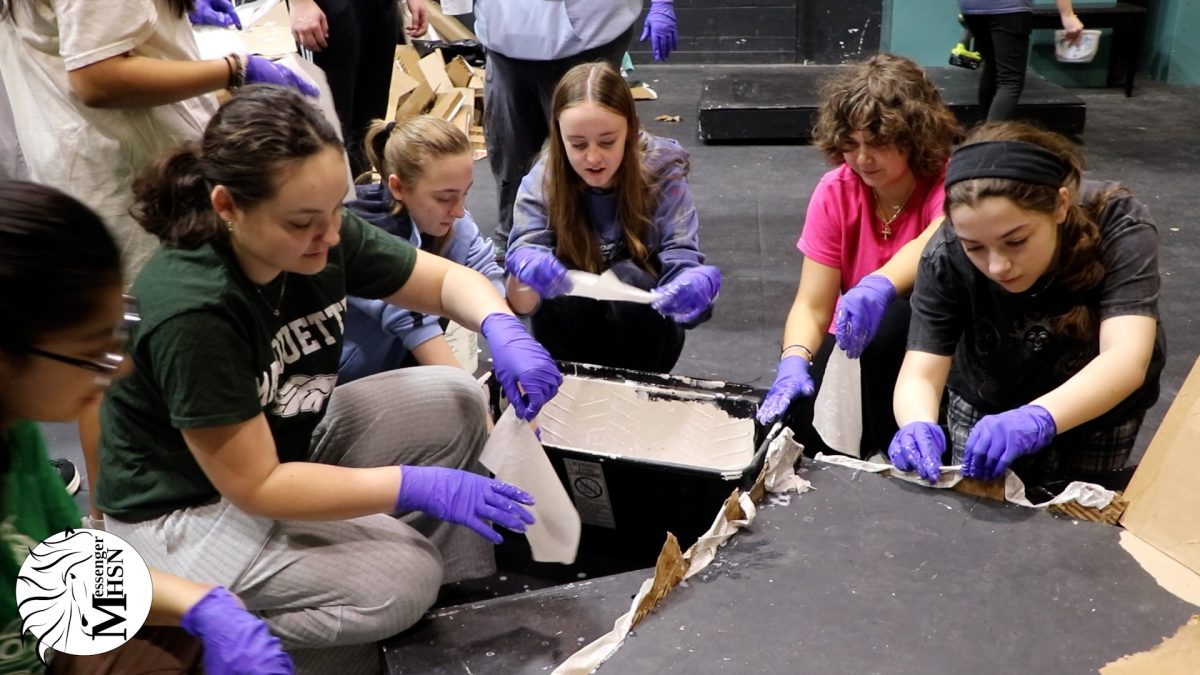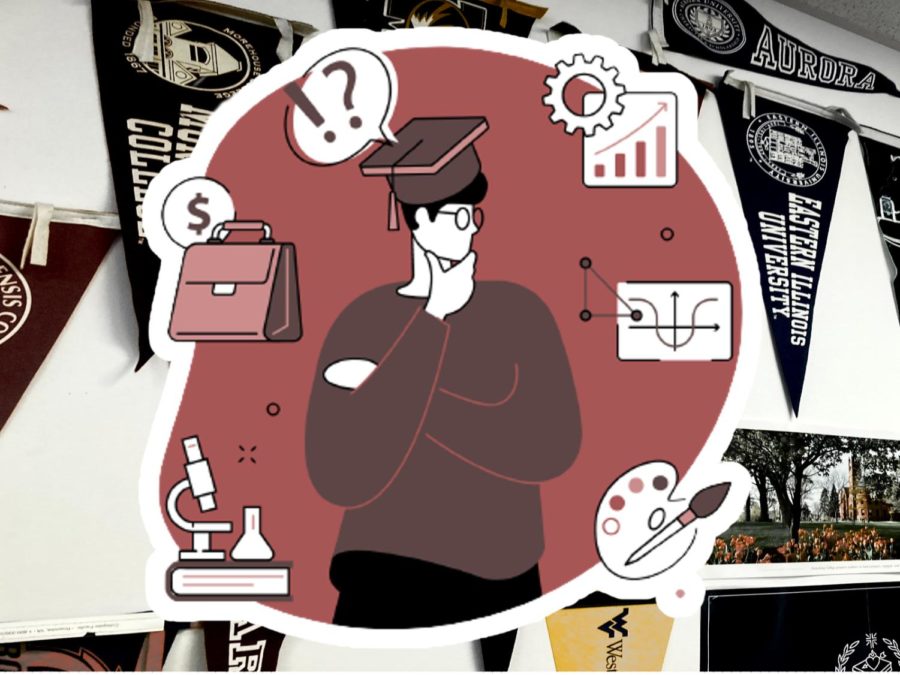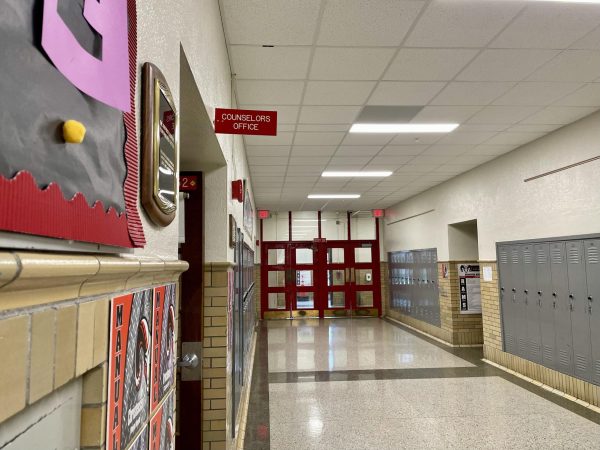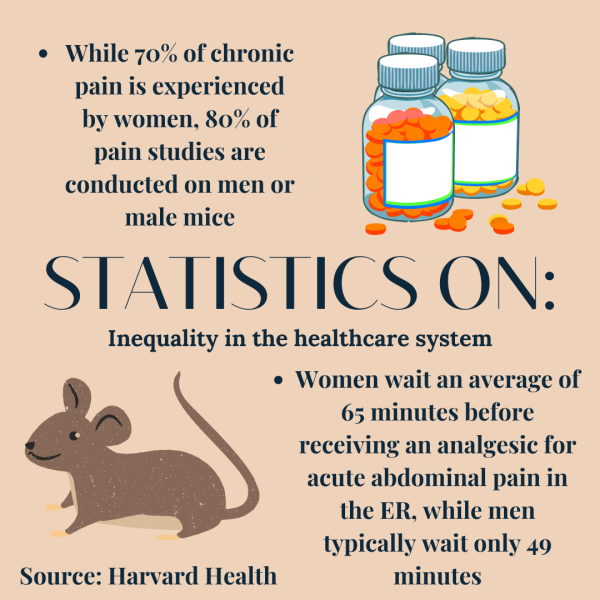College Myths: Separating Fact from Fiction
Mishal Nizar and Autumn Zayas
At Metea, 63% of students in the class of 2021 went to a four-year institution and 36% went to a two-year or technical school. However, that does not mean that success can not be achieved on other pathways.
May 11, 2022
In a few weeks, over 700 seniors are graduating in Metea’s class of 2022. Some may enlist in the military. But most students will attend a four-year university, and many of them will take on thousands of dollars in school loans. But is it worth it? Would other pathways be a better choice? College and the military are only two popular options out of the wide variety of options there are after high school.
Fall to spring is typically the college application season. It is a stressful time for students to figure out what they want to do after high school. This is why there are a variety of types of post-high school options, especially ones other than a four-year college that can still lead to a successful career. Even with these different pathways, misconceptions overshadow them and mislead students throughout the central process into adulthood.
Fostering a New Financial Perspective
The first part of the search process is to start with what a student can afford. Students can become wrapped with the college names, alumni, and even family traditions. When starting the process, students planning on going to college often rely on the “safety” and “reach” school brackets and their odds of admission. But students often focus on that without factoring in how much it costs to attend those schools. What is affordable and what is not? What is the bottom line for families financing college?
“I think that the financial piece to college is more important than ever,” Technology Center of DuPage (TCD) college and career pathway specialist Anthony Gliffe said.
Within the financial process, students turn to scholarships, loans, and grants to aid their finances. However, there is a student loan debt crisis in the United States and it is affecting the mid to lower-class people hard. America’s college graduates owe $1.7 trillion on their student loans. Students will often take a large sum of loans to pay for college, but struggle when paying that money back. There is already an underlying struggle within the financial process of students.
“I think that’s a big thing that we can do in this country is just having those conversations earlier with students and families,” Gliffe said. “Families should be having a financial talk with their son or daughter prior to starting the college process.”
The U.S. Department of Education offers a college financing plan for students ranging from undergraduate to graduate. Metea Valley offers a counseling website and has a specifically designed tab for college and career information. There are various resources that students and families can utilize and start that conversation with family or guardians about the upcoming future.
Starting the conversation is just the first puzzle piece to an entire array of outcomes leading to building a pathway toward the future. Now understanding what is affordable and what is not then a student can accurately picture what options are affordable.
Higher Education is Not Higher Quality
High school students and counselors toss out the terms “safety” and “reach” schools to organize colleges they look for. This can range from Ivy Leagues to community colleges where people differ based on their academic standpoints, aspirations, and family goals.
The Princeton Review uses the terms “dream,” “target,” and “safety” schools.
“Dream” or “reach” schools are schools categorized as the ultimate dream destination. This is where students typically look at the Ivy Leagues like Harvard, Yale, and Princeton. They may not meet the financial or academic requirements but it would be a dream come true to attend these schools.
“Target” schools include colleges where students meet the academic requirements and have a fair chance of getting accepted into that college.
Lastly, “safety” schools typically are categorized as community colleges or four-year schools that have academic admission requirements that are safely lower than the academics that the applicant has. Students are certain that they will be accepted by their safety schools.
However, “safety” schools are different for different students.
I personally get frustrated with the terminology that is used in high school as far as a safety school and a reach school. I personally think that’s disrespectful to all the schools to be viewed like that.
— Anthony Gliffe
When students look at colleges, the first thing that comes to mind is “reach,” “target,” or “safety.” It may be strategic for some students to group colleges based on a student’s academic standards, but there also comes a stigma of “reach,” “target,” and “safety” schools.
But do students ever think about how all their options like universities and community colleges differ academically? Society has been conditioned for so long that other post-high school options like the trades or community college are for those who are not “college material.” In reality, these do not differ at all.
Bradley Griffith, a graduating Doctor of Education student at the University of Arkansas at Little Rock, conducted a study on high school seniors to examine if community college has an impact on college decisions. He found that the stigma surrounding community college does, in fact, play a significant role. One student said “Community college is typically looked down on unless you’re just using it as a stepping stone to save money before transferring out to a better school. That’s what my family and friends have always thought.”
People have looked down on community colleges throughout the years as a degree that can not bring a student far in life as a four-year university would. That is the stigma that has been conditioned for so long as a “safety” school yet community colleges may not be “safe” for everyone.
More than 21,000 students attend the College of DuPage per semester, and more Metea Valley students attend COD than any other college. The college offers many opportunities for students such as financial aid packages, scholarships, and experiences within the community.
“College of DuPage is a good fit for everyone,” COD high school administration representative Stephanie Loconsole said.
There are opportunities for students who want a high financial aid package, look for an honors program, or even participate in research or internships at COD. The programs offered also cater to students who did not do well in high school and are looking for a fresh start. Students can have a new slate to build off of for their future regardless of what happened in high school.
“I think one of the biggest misconceptions that I’ve seen in my career is that the community college is only for students that can’t make it into a four-year,” Metea school and college counselor Tom Daugherty said.
There are resources in high school that help the college process like dual credits with community colleges. At Metea, students can earn college credits through COD by taking dual-credit courses such as anatomy or apparel construction, without traveling to the COD campus. This can help high school students in starting their college credits.
Another community college is the Technology Center of DuPage (TCD). TCD is the advanced, elective Career and Technical Education (CTE) campus serving 14 member high school districts. There are opportunities for students more specifically towards a student’s career aspirations. There are programs like cosmetology, cooking, and robotics. However, like COD, community college is not as talked about when students consider what college they want to attend.
“There’s this old notion: the trades used to be viewed as, well, you can go do a trade if you’re not college-level material,” TCD College and career pathway specialist Anthony Gliffe said.
TCD offers a variety of opportunities for its students to gain experience. There are programs for professional certifications, EMT, nursing, cosmetology, dual-credit, and apprenticeships. This allows their students to obtain specialized skills in the field of their choice so that when they seek employment, they have credibility.
Even TCD advisers and specialists have been in contact with companies that want both people with high-level academics and people with technical skills. Companies do not limit TCD students just because they go to a community college.
So, why are students limiting themselves to four-year universities? Higher education does not mean higher knowledge. Finances and family circumstances play a huge role in why many students refer to a community college. This idea is changing nowadays however, that misconception about community colleges is still prevalent.
“I feel like four years is good. It’s just that it’s not always an option for everyone,” Metea sophomore Adonis Robertson said.
Beyond the Reputation
When a school has a well-known reputation, many expectations can be brought up because of that. The Ivy League is the number one college in some people’s eyes: difficult colleges to get in and are academically rigorous. While that may be true, that can cause the misconception that they teach a different program from other schools. However, biology is biology. Medicine is medicine. Law is law. These are all programs that have the same foundational education.
“We come across that a lot with students coming to ask advice on if they should choose this college or that college because of the name,” TCD career counselor Michelle Miklinski said.
The reputation talk may cloud the judgment of incoming students. They may think that because of the name, that college is the one to pick. The amount of popularity surrounding an institution does not always mean that the quality of the institution adds up with it.
I don’t think [school and reputation] matter. I think it should be based on your skill set.
— Alicia Harris
In an article by the Evidence Base, Juan Saavedra studies why college reputation matters to students and employers. They conclude that reputation matters to employers because it is easy for employers to find pre-screened candidates, especially all students at the top colleges who have high college entry scores.
“I think, to an extent, [reputation] matters,” Northern Illinois University (NIU) transfer advisor Alex Torres said. “But I think the level of experience that a student got at a specific institution within their specific field [is more] indicative of how successful a student is going to be within the career”
Having a reputation can be an inaccurate picture of the student’s abilities to be in the workplace. There are other factors other than a person’s academic abilities that matter. The more employers rely on students with a higher reputation, the less they take into consideration students’ abilities to do the job.
According to Torres, some professions like nursing where they look at reputation are where reputation does matter. However, for the most part, it does not. A student’s resume should be about the level of experience that a student gained rather than where their education was.
“It is not until you get on the job that you’re really gonna learn,” Miklinski said.
Being able to check off that a student is qualified with on-the-job experience is more valuable than just having the education for it. It is the experience that goes beyond the reputation.
More Than One Path to Success
There are many different post-high school options that students can choose from: college, the military, vocational school, and more. At Metea, 63% of students in the class of 2021 went to a four-year institution and 36% went to a two-year or technical school. However, that does not mean that success can not be achieved on other pathways.
“I think it depends on what a person believes that their right path is,” Harris said. “College isn’t for everyone so I don’t think you should put a lot of pressure on someone who wouldn’t feel happy choosing to go to a four-year college.”
In an article by Education Next, Michael J. Petrilli defines the tradition behind college and how the old saying “college for all” is misguided. There is so much more to a person’s post-high school life than college. Petrilli encourages students to spend more time in “workplace apprenticeships, not traditional high school classrooms.”
High school requirements, course-taking, and testing all reflect the education system’s policies. For Petrilli, these policies promote college and career versus college or career pathways. Administrators in the education system remain uncomfortable with separate high school paths for students with different goals, skill sets, and academic backgrounds. As a result, students become more likely to choose a four-year university based on their educational background rather than having a fair choice of what should be their post-high school life.
“On a very general level, outside of certain exceptions to some schools, for the most part, you are going to be walking out with a quality degree and it’s gonna be up to you to take that next step,” Gliffe said.
What Now?
When asked if Metea should start the college talk earlier and include sophomores, both Adonis Robertson and Asma Khan agreed that sophomores should be included.
“Yes, because freshman year is just like you’ve started off and sophomore year is like where you understand what you’re going for,” Robertson said.
When students begin high school, they typically do not understand the different pathways, even within high school let alone what the different pathways are after high school. Robertson found that he could and is currently working towards graduating early by finishing his required credits.
“I feel like it would be better if we dig deeper into [college] so we’re ready for our junior year,” Khan said.
Khan’s parents are more open to the idea that she does not have to go to college. However, Khan has a plan in going to college for her upcoming future.
There are a lot of conversations that need to be happening throughout the college process. There are finances and school names. Daugherty, however, thinks that there should be conversations even prior to those talks.
What needs to happen for all of our students to be successful is for them to find the right post-secondary path.
— Tom Daugherty
Many students can become wrapped up in these misconceptions, such as reputation and dream schools. But what is affordable? What is efficient? What passions do they want to follow? There are various colleges in the nation that ultimately offer the same education.
“At the end of the day, your degree is your degree. It allows you to check the box that you are qualified to apply for this certain job or career,” Gliffe said.
This story was originally published on Metea Media on May 9, 2022.





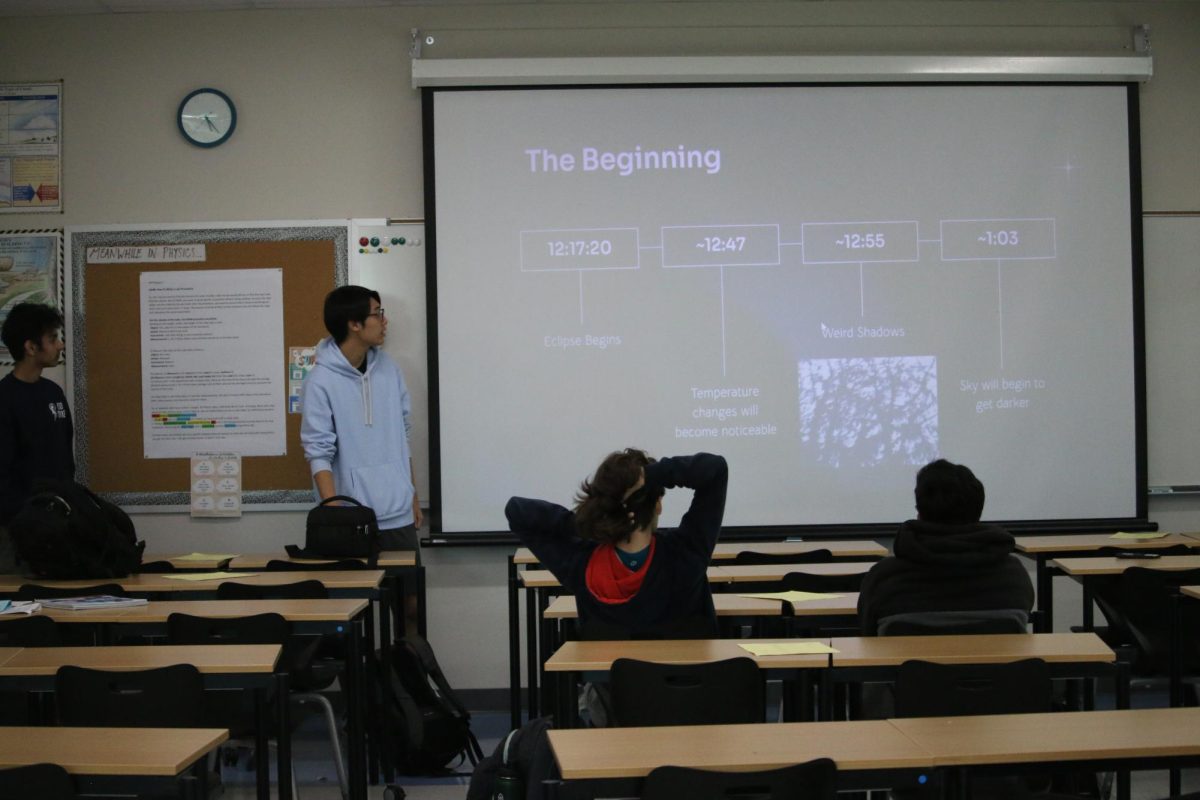
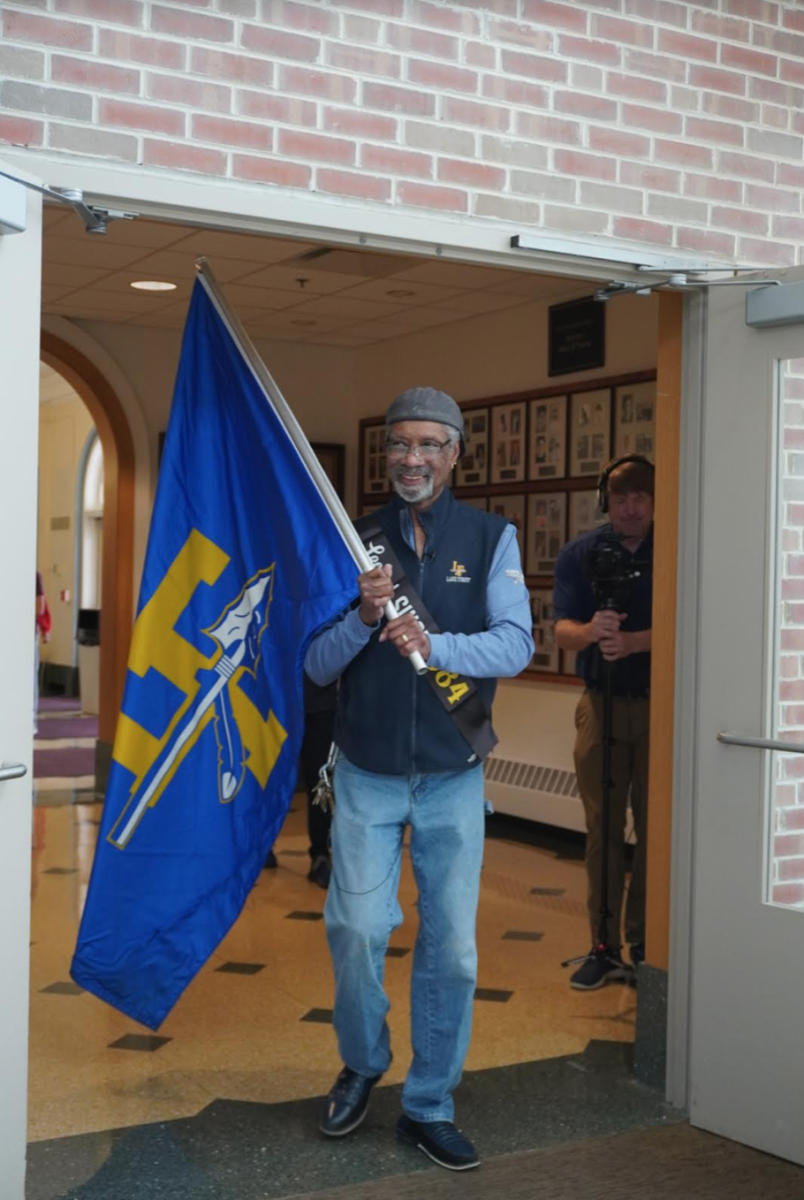





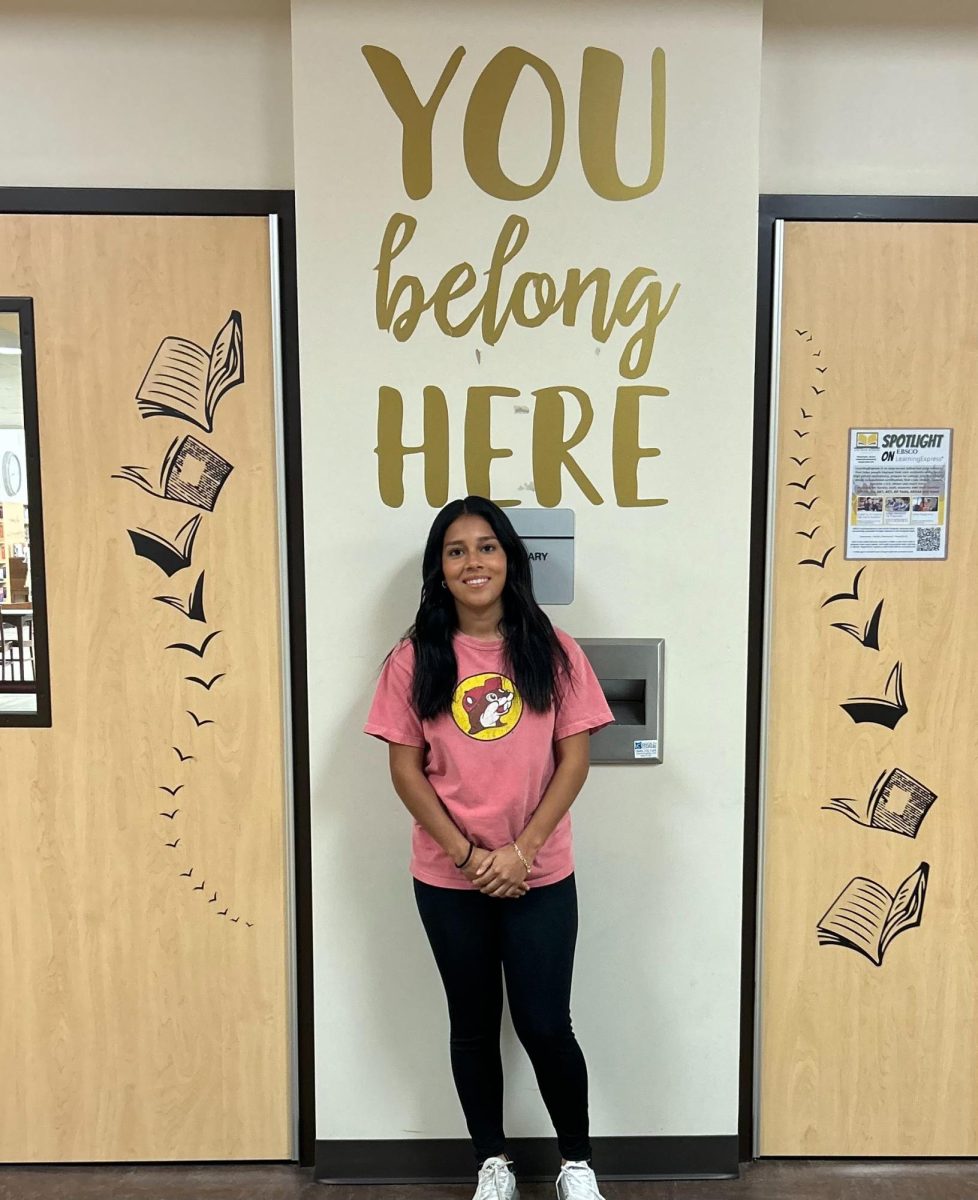















![IN THE SPOTLIGHT: Junior Zalie Mann performs “I Love to Cry at Weddings,” an ensemble piece from the fall musical Sweet Charity, to prospective students during the Fine Arts Showcase on Wednesday, Nov. 8. The showcase is a compilation of performances and demonstrations from each fine arts strand offered at McCallum. This show is put on so that prospective students can see if they are interested in joining an academy or major.
Sweet Charity originally ran the weekends of Sept. 28 and Oct. 8, but made a comeback for the Fine Arts Showcase.
“[Being at the front in the spotlight] is my favorite part of the whole dance, so I was super happy to be on stage performing and smiling at the audience,” Mann said.
Mann performed in both the musical theatre performance and dance excerpt “Ethereal,” a contemporary piece choreographed by the new dance director Terrance Carson, in the showcase. With also being a dance ambassador, Mann got to talk about what MAC dance is, her experience and answer any questions the aspiring arts majors and their parents may have.
Caption by Maya Tackett.](https://bestofsno.com/wp-content/uploads/2024/02/53321803427_47cd17fe70_o-1-1200x800.jpg)
![SPREADING THE JOY: Sophomore Chim Becker poses with sophomores Cozbi Sims and Lou Davidson while manning a table at the Hispanic Heritage treat day during lunch of Sept 28. Becker is a part of the students of color alliance, who put together the activity to raise money for their club.
“It [the stand] was really fun because McCallum has a lot of latino kids,” Becker said. “And I think it was nice that I could share the stuff that I usually just have at home with people who have never tried it before.”
Becker recognizes the importance of celebrating Hispanic heritage at Mac.
“I think its important to celebrate,” Becker said. “Because our culture is awesome and super cool, and everybody should be able to learn about other cultures of the world.”
Caption by JoJo Barnard.](https://bestofsno.com/wp-content/uploads/2024/01/53221601352_4127a81c41_o-1200x675.jpg)



